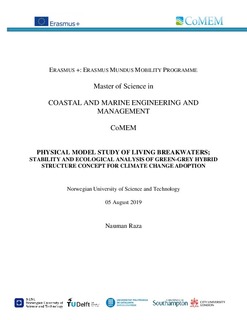| dc.description.abstract | A vast majority (84%) of all countries in the world have coastlines and 80-100% of their
population resides within 100 km of the shoreline. Studies show a major growth in population
in low-elevation coastal zones and a scenario of rising sea level may force millions
of people to relocate. To deal with the increased frequency of extreme events and sea level
rise, coastal vegetation (mangroves, salt marches and coral reefs) has been observed to act
as an effective natural barrier. Coral reefs are believed to reduce upto 90% of wave energy
but increasingly warming oceans and acidification are destroying this barrier by coral
bleaching. Apart from a social, ecological and environmental damage, this will also result
in an increase in environmental loading on coastal structures.
This study focuses on the development of a climate change adoption measure for existing
structures on the principles of Sustainability. In order to do so, a representative existing
breakwater at Kiberg Norway is chosen. A brief ecology study of the area is conducted
and based on economic value and vulnerability, Red King Crabs and Capelin are chosen
as target species. A green-grey hybrid structure consisting of an existing breakwater with
additional Artificial Reefs (AR) as toe elements is hypothesized to be the suitable solution.
However, hydraulic performance of AR is still not understood properly and to utilize them
to enhance the stability of existing breakwater may create tension between hydrodynamic
and ecological performance.
In order to investigate the hydraulic behaviour of hybrid structure, physical model study
is conducted. A traditional method of using transmission coefficient to quantify energy
dissipation over submerged/non-submerged AR breakwater is not suitable for this hybrid
structure. Therefore, stability of existing breakwater is measured in terms of damage level
(Ahrens and Cox, 1990) and indirectly by turbulent kinetic energy (Mukaro and Govender,
2013) for 9 plunging and 6 surging wave conditions. Four configurations of experimental
setup are finalized with four types of AR units (AR1, AR2, AR3 and AR4) and in total
175 tests are carried out. Behaviour of breaking and non-breaking waves is observed to be
different especially over config-3 and config-4. Landward vortex and breaker tongue are
not fully developed in config-3 due to depth limited scenario. Additional non-linearities in
the flow, due to interaction of incoming and secondary waves, are observed for config-4,
which resulted into higher reflection coefficient than other configurations.
Behaviour of a hybrid structure can be predicted by Van der Meer stability formulas for
plunging and surging waves at lower wave heights. However, higher waves exhibit greater
damage reduction and formulas show larger deviations. Results indicate that one row of
AR placed as toe, does not reduce much damage (10%). A comparison of all the configurations
indicate that config-3 and config-4 show an average damage reduction of 38% and
51% respectively. Critical stability number of config-4 (i.e. 1:45) is lower than of config-1
(i.e. 1:7), indicating that disturbing forces are becoming weaker due to the presence of AR.
Residence time of wave on reef is believed to be of much importance and with a 15m
reef length a damage reduction upto 45% is observed. Reef porosity is observed to have
dependency on placement location and reef length. Ecological performance is predicted to
increase by 25% in 10 years of construction. However, differently chosen indicator species
might have shown better results.
It is concluded from the study that green-grey hybrid structures can be a suitable short-term
climate change adoption measure. | |
